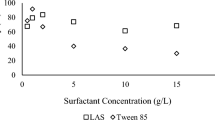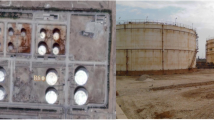The goal of this work was to determine the effectiveness of various surfactant-based reagents and disclose the interrelationships of the effectiveness of the reagent and the type of the soil being cleaned, the concentration of the working reagent solution, and the alkalinity of the solution. It was found that reagents containing anionic and nonionic surfactants and their working solutions having high pH values are most effective. However, this parameter is not decisive for both petroleum hydrocarbons and natural organic compounds. Study of the influence of sorption capacity of soil matrices on the effectiveness of soil cleaning by reagent treatment revealed that sorption of molecules of contaminating matters and molecules of surfactants markedly reduces the overall effectiveness of leaching out of organic matters from the soils.




Similar content being viewed by others
References
A. F. Tumanyan, N. V. Tyutyuma, A. N. Bondarenko, et al., Chem. Technol. Fuels and Oils, 53, No. 3, 369-376 (2017).
A. F. Tumanyan, E. K. Vatovskaya, and N. V. Tyutyuma, Chem. Technol. Fuels and Oils, 49, No. 2, 180-186 (2013).
D. I. Khalilova and D. M. Yunusova, Byul. Rezult. Nauchn. Issled., No. 1-2, 23-31 (2017).
Russian Federation Patent 2244685.
E. A. Beznozdreva, D. S. Vorob'ev, L. G. Emel'yanova, et al., Collection of Innovative Solutions of Biodiversity Conservation for Oil Refining Sector [in Russian]. 000 RA IL'F, Moscow (2015), p. 275.
A. A. Izosimov, Physicochemical Properties, Biological Activity, and Detoxifying Capacity ofMimic Compounds Differing in Origin of Organic Matter [in Russian], Biological Science Candidate’s dissertation, Moscow (2016).
A. I. Popov, Humic Matters: Properties, Constitution, Formation [in Russian], Izd. S., St. Petersburg (2004), p. 248.
NFESC Technical Report TR-2206-ENV Surfactant-Enhanced Aquifer Remediation (SEAR) Design Manual [Electronic resource]/EOS Remediation [official site], URL: http://www.eosremediation.corn/download/Source%20Zones/SEAR/SEAR%20Design%20Manual.pdf (accessed: 09.10.2018).
A. Zubair, Design and optimization of surfactant based enhanced remediation of bunker fuel contaminated soil, St. John's, Newfoundland, Canada (2015), p. 182.
The authors express their gratitude to Dr. V A. Terekhova, Professor, M. V. Lomonosov Moscow State University, for supplying the samples of chernozem of the Voronezh Region, ISO 11268-2 standard soil, and crude oil of the TsPS Varyegan field.
Author information
Authors and Affiliations
Corresponding author
Additional information
Translated from Khimiya r Tekhnologiya Topliv i Mani, No. 6, pp. 47-51, November — December, 2018.
Rights and permissions
About this article
Cite this article
Kulikova, O.A., Mazlova, E.A., Bradik, D.I. et al. Use of Surfactant-Based Reagents for Cleaning Oil-Contaminated Soils. Chem Technol Fuels Oils 54, 743–750 (2019). https://doi.org/10.1007/s10553-019-00982-1
Published:
Issue Date:
DOI: https://doi.org/10.1007/s10553-019-00982-1




